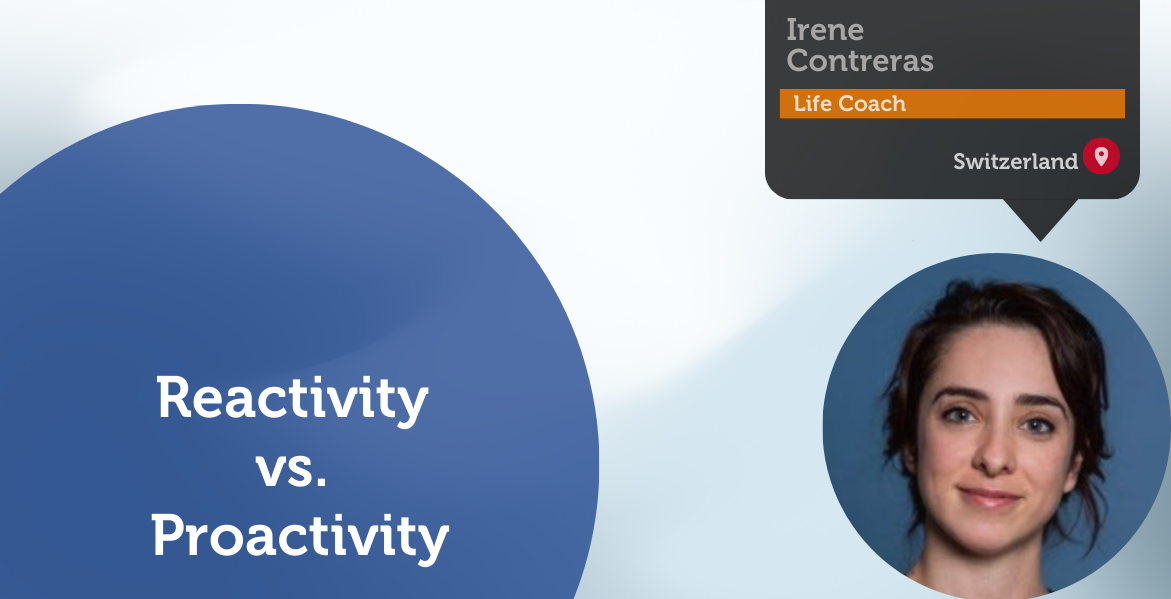A Coaching Power Tool By Irene Contreras, Life and Healthy Leadership Across Cultures Coach, SWITZERLAND

Reactivity vs. Proactivity: Dealing With Change Management
We tend to believe that drastic changes are far away from us. They belong to other industries, to other professions, or, to the distant future.
But Change has a way of sneaking up on us. Always.
We may wake up one day to find that our industry has been revolutionized, our skills have become obsolete, or our careers have been shaken by unexpected events.
It is crucial that we learn to anticipate and manage change rather than ignore it and wait for it to go away, only to find ourselves in a struggling position when change is unavoidable.
Life is change. Growth is optional. Choose wisely. Karen Kaiser Clark.
Reactivity and proactivity are two different approaches to life and to how we can handle change.
Reactivity vs. Proactivity: But What Is Reactivity and What Is Proactivity?

Proactivity refers to the act, characteristic, or habit of thinking and acting so as to prepare to intervene in, or control expected events, especially negative or challenging ones. It implies taking initiative and acting in advance to anticipate and prevent potential issues or challenges.
A proactive approach involves being forward-thinking, setting goals, planning, and taking steps to achieve desired outcomes.
Reactivity involves responding to events or situations after they have occurred. Reactive individuals tend to be more passive, they wait for external circumstances to dictate their actions.
Living in a “Reactive mode” can have several impacts on individuals and their lives:
- Lack of control: when a person is in a constant reactive mode, she or he may feel that the external circumstances are controlling their life, leading to a sense of powerlessness or frustration.
- Loss of focus: living life from a reactive perspective tends to shift the focus from long-term goals to immediate demands, to a feeling of constantly putting out fires.
- Increased stress: the constant pressure of dealing with unexpected events and being on the defensive side can take a toll on the overall emotional well-being of a person.
- Missed opportunities: growth and development are put aside, as reactive individuals tend to be more hesitant and do not seek out new possibilities.
However, it is important to note that reactive responses are sometimes necessary. The key is to find the balance between reactivity and proactivity – being reactive when needed but operating mostly from a proactive perspective.
How Can Coaching Help You Flip Your Reactivity Into Proactivity?
Coaching empowers clients to take ownership of their actions, make conscious choices, and actively work towards their goals. As a coach, you can encourage proactivity by helping clients clarify their vision, identify potential obstacles, and develop strategies to overcome them.
By incorporating this concept into coaching, clients can develop a proactive mindset that enhances their personal and professional growth.
What Can You Do With Reactivity vs. Proactivity to Help Your Clients Implement Proactivity in Their Lives?
- Raise Awareness Help your client take some time to reflect on their own patterns. Are they more inclined to react immediately without considering the bigger picture? Do they often find themselves caught up in a cycle of responding to urgent matters? Identifying certain patterns can help them recognize their default modes of operating and explore the benefits of proactivity. By raising awareness about the impact of being reactive, clients can become more conscious of their choices and the potential benefits of adopting a proactive approach. Mindfulness techniques can assist in developing self-awareness.
- Clarify Values and Goals Proactivity is closely linked to goal setting. As a coach, we can assist our clients in defining clear, meaningful goals in different areas of their lives, such as career, relationships, health, and personal or professional development. We can partner with them in designing action plans that promote proactive behaviors. It could be, for example, by identifying specific steps, allocating resources, and establishing timelines. Revisit with your clients their values and goals and use them as a compass in decision-making. Clearly defined goals provide a sense of direction and purpose.
- Focus On Problem-Solving As a coach, we can guide our clients in adopting a proactive problem-solving mindset. Clients can learn to prioritize and plan, think ahead, anticipate potential hurdles, challenges, or opportunities, and develop strategies to address these issues in advance. Rather than dwelling on problems, the focus should be shifted to finding ways to overcome obstacles.
- Mindset Shift As a coach we want to help our clients shift their mindset from reactive to proactive by reframing situations, encouraging a solutions-oriented approach, and cultivating the client’s self-confidence in their own ability to create positive change, to seize opportunities for growth and advancement. Clients with a proactive mindset will commit to lifelong learning: they will stay curious, seek knowledge, and acquire new skills relevant to their goals.
- Support and Accountability As a coach, we can provide support and hold the client accountable for their goals. We are there for them so they can share their progress and challenges with us, and we help them stay on track and maintain a proactive mindset. We celebrate their successes along the way, help them learn from setbacks, and adapt their approach as needed.